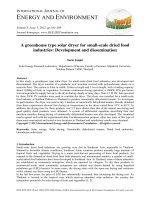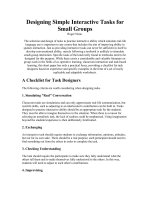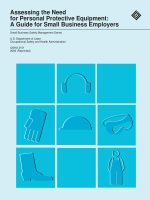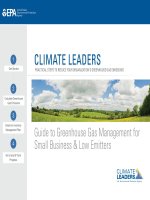Downward approach for streamflow estimation, forecasting for small scale to large scale catchments learning from data
Bạn đang xem bản rút gọn của tài liệu. Xem và tải ngay bản đầy đủ của tài liệu tại đây (2.03 MB, 118 trang )
DOWNWARD APPROACH FOR STREAMFLOW ESTIMATION,
FORECASTING FOR SMALL-SCALE TO LARGE-SCALE
CATCHMENTS: LEARNING FROM DATA
BASNAYAKE MUDIYANSELAGE LEKHANGANI ARUNODA BASNAYAKE
(B. Sc. Eng. (Hons), University of Peradeniya, Sri Lanka)
A THESIS SUBMITTED
FOR THE DEGREE OF DOCTOR OF PHILOSOPHY
DEPARTMENT OF CIVIL AND ENVIRONMENTAL ENGINEERING
NATIONAL UNIVERSITY OF SINGAPORE
2012
i
ACKNOWLEDGEMENTS
First and foremost, I wish to express my sincere gratitude to my supervisor,
Associate Prof. Vladan Babovic for his guidance, valuable advices, and constant
support, which lead to the completion of my doctoral study. He has been an excellent
advisor for me during my years in National University of Singapore.
I express my sincere appreciation to Dr. Rao Raghuraj, for his guidance,
encouragements, and helpful suggestions during the initial stage of my research. I am
also grateful to the other members of my dissertation committee, Prof. Cheong Hin
Fatt, and Assistant Prof. Chui Ting Fong May, whose suggestions and constructive
comments guided me through the research.
I am grateful to all my laboratory mates and my friends who have helped
during my doctoral study at National University of Singapore. Heartfelt gratitude is
extended for the entire family members of Civil Engineering Department. Very special
thank goes for the entire family members of Singapore-Delft Water Alliances
(SDWA). I would like to express my sincere thanks to all who, directly or indirectly,
contributed in many ways to the success of my research.
I thankfully acknowledge the National University of Singapore for granting me
research scholarship to pursue the degree of Doctor of Philosophy. I gratefully
acknowledge the financial support of the Singapore-Delft Water Alliance (SDWA).
Last but not least, I would like to thank my parents and my husband for their
love, inspirations and constant support during this intensive learning period and in
every step of my life.
ii
TABLE OF CONTENTS
Page No.
ACKNOWLEDGEMENTS
i
TABLE OF CONTENTS
ii
SUMMARY
vi
LIST OF TABLES
ix
LIST OF FIGURES
x
LIST OF SYMBOLS
xiii
CHAPTER 1: INTRODUCTION
1
1.1 Rainfall-runoff (R-R) process modelling
1
1.1.1 Process-based models
2
1.1.2 Data driven models (DDMs)
2
1.2 Problem statement
3
1.3 Objectives of the study
5
1.4 Organization of the thesis
6
CHAPTER 2: LITERATURE REVIEW
8
2.1 Runoff generating processes
8
2.1.1 Process scale
10
2.1.2 Hydrological process scales
9
2.1.3 Observation (Measurement) scale
12
2.2 Rainfall-runoff (R-R) process conceptualization approaches
13
iii
2.2.1 Upward approach
13
2.2.2 Downward approach
13
2.3 Rainfall-runoff (R-R) modelling with data driven techniques
15
2.4 Streamflow forecasting with data driven techniques
19
2.4.1 Distributed and lumped flow routing
21
2.4.2 Global and cluster-based flow routing
23
2.5 Effect of data resolution on rainfall-runoff (R-R) process
approximation
26
2.6 Accuracy of multi-step-ahead forecasts
28
2.7 Artificial neural networks (ANNs)
29
2.7.1 Input determination
30
2.7.2 Training neural nets
32
2.7.3 Extrapolation capability
33
2.7.4 Optimal model complexity
33
2.8 Summary
37
CHAPTER 3: EFFECT OF DATA TIME INTERVAL ON
RAINFALL-RUNOFF (R-R) MODELLING
38
3.1 Introduction
38
3.2 Case study
38
3.3 Input determination
39
3.4 Forecasting models
41
3.5 Performances of rainfall-runoff (R-R) models
42
3.5.1 Effect of data time interval on forecasting accuracy
44
3.5.2 Iterative and direct forecasting
48
iv
3.6 Conclusions
50
CHAPTER 4: MODULAR DATA DRIVEN APPROACH FOR
RAINFALL-RUNOFF (R-R) MODELLING
52
4.1 Introduction
52
4.2 Case study
53
4.3 Identification of hydrological regimes: Self-Organizing Maps
(SOMs)
53
4.4 Forecasting models
54
4.4.1 Linear forecasting models
54
4.4.2 Nonlinear forecasting model: Artificial Neural Networks (ANNs)
55
4.5 Performances of global and modular rainfall-runoff (R-R) models
55
4.5.1 Model performance in rainfall-runoff (R-R) process representation
55
4.5.2 Linear and nonlinear model performances in global and modular
model representations
65
4.5.3 Model performance in multi-step-ahead forecasts
69
4.5.4 Extrapolation capability of global and modular models
73
4.6 Conclusions
75
CHAPTER 5: FLOW ROUTING WITH DATA DRIVEN MODELS
77
5.1 Introduction
77
5.2 Description of the White river catchment
77
5.3 Input determination
78
5.4 Sequential flow routing method
81
5.5 Cluster-based flow routing
86
v
5.5 Conclusions
90
CHAPTER 6: CONCLUSIONS AND RECOMMENDATIONS
92
REFERENCES
95
LIST OF PUBLICATIONS
103
vi
SUMMARY
Data driven models (DDMs) are recognized as models that offer
computationally fast yet sufficiently accurate solutions for modelling complex
dynamical systems. In so doing, DDMs are used in operational management systems.
Current applications of DDMs on rainfall-runoff (R-R) process modelling are limited
to finding a function for all runoff generating instances. These studies are rather
general and not specific enough to capture the temporal and spatial variation of R-R
processes. Therefore, from the operational perspective, it is highly imperative to find
out the means of improving R-R process representation of DDMs and other influential
factors on forecasting accuracy. The objectives of this research were: (1) to review the
data driven streamflow estimation applications to understand the reasons for the
model-attributed estimation errors, (2) to investigate the effect of data time interval
and model complexities on streamflow estimation and forecasting, (3) to classify
temporally dominant runoff generating processes, (4) to develop and evaluate a
modular data driven model for estimating streamflow of lump catchments, (5) to
develop and evaluate a sequential flow routing method, and (6) to investigate the
applicability of cluster-based modelling for distributed flow routing. Artificial neural
networks (ANNs) was the data driven modelling method in this research.
Orgeval catchment of France was chosen to illustrate the problems associated
with lumped catchment R-R models. First, the effect of data time interval was
investigated using 1 hour (hr), 2 hr, and 3 hr sampled data. Two analyses were
performed using absolute discharge data (Q) and differenced discharge (dQ) data. Both
analyses showed that accuracy improved with refined data and results were
comparable. However, errors of ANN model trained with Q data were much higher in
multi-step-ahead forecasts and in out-of-range forecasts. Models trained with dQ data
vii
tend to generate more accurate forecasts. It was found that both improvements in
runoff estimation, i.e., at one-step-ahead forecasts, and error accumulation property
have significant impact on multi-step-ahead forecasts. The range of data time interval
is not continuous and fine sampled data can deteriorate the model estimations due to
the noise in data. This needs further investigation.
This thesis also presents a systematic approach for streamflow estimation in
lump catchments; firstly to identify the temporally dominant processes and secondly to
represent each local region by separate models; in an attempt to obtain improved
estimation. Classification results showed that dQ and rainfall model inputs
successfully identified the temporally dominant processes. Application of classified
inputs to locally specialized models showed that the proposed modular model
approach is feasible and effective. Improvement in predictability with modular model
approach will depend on the degree of complexity of R-R process.
Finally, possibility of extending the research basis of lump catchment models
into large-scale catchments was examined. A sequential flow routing model was
developed for the West Fork of the White river, Indiana. In the first part of the study,
single-station models were developed, firstly using the nearest upstream station data
and secondly with all existing upstream flow data. Then, single-station models were
sequentially applied to estimate the downstream flows. The model performance was
evaluated with different data time intervals. Comparison of model results indicated that
single river reach model performance could be improved with temporally refined data.
In the second part of this study, cluster-based modelling was applied to improve the
flow estimations. Simulation results of this analysis indicated that cluster-based
modelling was a promising method to improve the streamflow forecasts. The proposed
viii
approach was found to improve the forecasts over longer prediction horizon. This can
be coupled with hydrological information to improve intra-catchment process
variations.
It is believed that this research contribution will provide the basis for
subsequent studies on data driven R-R process modelling and for other related data
driven applications.
ix
LIST OF TABLES
Page
Table 3.1
Q-ANN model performance with data time interval.
46
Table 3.2
dQ-ANN model performance with data time interval.
46
Table 4.1
Parts of the hydrograph represented by each classification.
62
Table 4.2
Error accumulated due to the classification error in dQ-MNN
models.
71
Table 5.1
Statistics of the streamflow time series data (m
3
/s).
78
Table 5.2
Performances of single station models of Centerton and
Newberry.
85
Table 5.3
Difference of statistical measures of GM
SS
and GM
MS
models
with data time interval.
86
x
LIST OF FIGURES
Page
Figure 2.1
Runoff generating processes (Maidment, 1993).
9
Figure 2.2
Process scale in time. (a) Duration (temporal extent of the
process); (b) Temporal cycle; (c) Correlation time (Bloschl and
Sivapalan, 1995).
10
Figure 2.3
Major controls on runoff generation mechanisms (Dunne, 1983).
10
Figure 2.4
Characteristic space-time scales of hydrological processes
(Bloschl and Sivapalan, 1995).
11
Figure 2.5
Observation scale in time. (a) Temporal extent; (b) Integration
time; (c) Data time interval (Bloschl and Sivapalan, 1995).
12
Figure 2.6
Dependency of observation scale and process scale (Bloschl and
Sivapalan, 1995).
13
Figure 2.7
The representation of a process in data driven models
(Solomatine and Ostfeld, 2008).
15
Figure 2.8
(a) Separation of sources of streamflow on an idealized
hydrograph, (b) Sources of streamflow during a dry period, and
(c) during a rainfall event. (Maidment, 1993).
18
Figure 2.9
Relative importance of the sub-processes at different times
(Mays, 2005).
18
Figure 2.10
(a) Propagation of a flood wave, (b) Storage-discharge
relationship.
24
Figure 2.11
Three-layered multi-layer perceptron (MLP).
30
Figure 2.12
Illustration of the bias/variance trade-off (Nelles, 2001).
35
Figure 2.13
Training and testing error variation with the model complexity.
36
Figure 2.14
Basic building block of MLP (Xiang et al., 2005).
37
Figure 3.1
The Orgeval catchment (Anctil et al., 2009).
39
Figure 3.2
Autocorrelation coefficient variation of absolute discharge (Q)
data, and cross-correlation coefficient variation of absolute
discharge (Q) and rainfall data for 1hr, 2hr, and 3hr sampled
data.
40
xi
Figure 3.3
Autocorrelation coefficient variation of differenced discharge
(dQ) data, and cross-correlation coefficient variation of
differenced discharge (dQ) and rainfall data for 1hr, 2hr, and 3hr
sampled data.
40
Figure 3.4a
Performances of ANN models for hourly data.
43
Figure 3.4b
Performances of ANN models for 2 hr sampled data.
43
Figure 3.4c
Performances of ANN models for 3 hr sampled data.
43
Figure 3.5
Absolute error (scaled) produced by Q-ANN and dQ-ANN
models.
44
Figure 3.6
Effect of data time interval (ΔT) on model error.
48
Figure 3.7
Iterative and direct forecasting performances of Q-ANN models.
49
Figure 3.8
Iterative and direct forecasting performances of dQ-ANN
models.
50
Figure 4.1
Schematic representation of the proposed modelling approach.
54
Figure 4.2
Performances of the Q-MNN models.
56
Figure 4.3a
Position of classes in; (a) 2-class, and (b) 3-class classifications.
57
Figure 4.3b
Position of classes in; (a) 4-class, and (b) 6-class classifications.
58
Figure 4.4
Performances of the dQ-MNN models.
59
Figure 4.5a
Position of classes in; (a) 2-class, (b) 3-class, and (b) 4-class
classifications.
60
Figure 4.5b
Position of classes in; (a) 6-class, and (b) 8-class classifications.
61
Figure 4.6
(a) Rainfall pattern; (b) dQ pattern.
63
Figure 4.7
Improvement in forecasts of local models compared to global
models.
64
Figure 4.8
Performances of ARX and ANN models in global model (GM)
and modular (MM) representations.
65
Figure 4.9
Improvement of forecasts in nonlinear local models compared to
linear local models.
66
xii
Figure 4.10
Flow duration curve for Orgeval catchment
67
Figure 4.11
Performances of the dQ-MNN models.
70
Figure 4.12a
Error accumulated due to the classification error in individual
classes of (a) dQ-MNN-C2, (b) dQ-MNN-C3, and (c) dQ-MNN-
C4 models.
72
Figure 4.12b
Error accumulated due to the classification error in individual
classes of (a) dQ-MNN-C6, and (c) dQ-MNN-C8 models.
73
Figure 4.13
Performance of models for out-of range data.
74
Figure 5.1
White river catchment.
77
Figure 5.2
Streamflow time series of the year 1992.
79
Figure 5.3a
Corss-correlation coefficient and auto-correlation coefficient
variation for Q data.
80
Figure 5.3b
Corss-correlation coefficient and auto-correlation coefficient
variation for dQ data.
81
Figure 5.4
Contribution of upstream flows on the streamflow estimations at
Newberry (N), Centerton (C), and Indianapolis (I).
82
Figure 5.5
Streamflow estimation at downstream stations.
83
Figure 5.6
Performance of Q-ANN and dQ-ANN models in estimating,
forecasting flows at Newberry.
84
Figure 5.7a
Class positions in Centerton discharge time series for 2-class
classification.
87
Figure 5.7b
Class positions in Centerton discharge time series for 4-class
classification.
88
Figure 5.9
Performances of global model (GM) and modular neural network
(MNN) models at Indianapolis (I), Centerton (C), and Newberry
(N).
89
xiii
LIST OF SYMBOLS
R-R
Rainfall-runoff
ANNs
Artificial neural networks
DDMs
Data driven models
ARX
Auto Regressive with eXogeneous
∆T
Data time interval
SOMs
Self-organizing maps
MLP
Multi-layer perceptron
Q
Absolute discharge
dQ
Differenced discharge
R
Rainfall
MAE
Mean absolute error
r
Correlation coefficient
FFNN
Feed-forward neural network
RNN
Recurrent neural network
Q
o
Observed discharge
Q
P
Predicted discharge
Mean observed discharge
Mean predicted discharge
AE
Absolute error
I
Inflow
K
Flow travel time
xiv
S
Storage
Weighting factor
LM
Local model
MM
Modular model
GM
Global model
SNN
Single neural network
MNN
Modular neural network
1
CHAPTER 1
INTRODUCTION
1.1 Rainfall-runoff (R-R) process modelling
Streamflow estimations are required over a wide range of discharge states, for
example, for the design and operation of hydraulic structures, for real time
management of the water resource systems, for the prediction of the effect of land-use
and climate change, and as model inputs for other interacting process models like
water quality models. The streamflow estimation models attempt to emulate the
complex hydrological processes that transform rainfall into streamflow (runoff), with
varying degrees of abstraction. Then, these rainfall-runoff (R-R) process models can
be used to compute the streamflows, mainly at non-measurement stations and into the
future. The decisions on planning and management of water resources are made based
on the model forecasts and therefore depend on the accuracy and reliability of
forecasts. Hydrological processes are nonlinear and complex processes. As a result,
model approximations cannot reproduce the behaviour of those processes exactly.
Error due to this process-model mismatch is known as bias error or model structure
uncertainty. In addition to bias error, parameter errors and measurement errors
collectively contribute for the uncertainties in hydrological predictions (Liu and Gupta,
2007). Model structure uncertainty is more likely to be dominant than other two types
of errors and thereby identification and reduction are vital for operational modelling.
R-R process models are basically derived from the general principles of
physical processes or measurement data itself. These modelling approaches are
generally known as process-based models and data driven models (DDMs),
respectively. The next two subsections will outline these approaches highlighting their
merits and demerits.
2
1.1.1 Process-based models
Process-based models are derived from the descriptive equations of the
hydrological processes. These equations that describe the temporal and spatial
evolution of the sub-processes, are in general partial differential equations form that
cannot be solved analytically. Therefore, solutions are found by finite difference
representations, which involve form of discretization in space and time ordinates. This
introduces errors which depends on the numerical method. Any model definition is an
abstraction of knowledge what we have on hydrology. If some hydrological processes
are not well understood those are represented by empricial generalizations. On the
other hand, process-based models require large number of parameters that describe the
physical characteristics of the catchment on a spatially distributed basis. Uncertainties
in these parameters also contribute to the model error. Based on these, we can confirm
that the incomplete understanding of the runoff generation processes and their
representation lead to bias errors in process-based models. However, process-based
models are distributed as equations involved space coordinates. Those are of great
importance in understanding of the hydrological processes. Model simulations at short
time steps are required to incorporate the nonlinearirites and to maintain stable
solutions. This makes computationally expensive model runs and limits their
application in operational management systems.
1.1.2 Data driven models (DDMs)
In DDMs, like artificial neural networks (ANNs), regression equations, and
genetic programming, a function is approximated using the system inputs and output
without imposing a functional relationship. It is determined in the training process by
optimising the number of possible functions.
3
Unlike process-based models, DDMs are computationally fast and therefore
applicable for real-time applications (Proano et al., 1998). Those are widely applied to
various hydrological problems (ASCE, 2000a, b; Babovic and Abbott, 1997a, b;
Babovic and Keijzer, 2002; Babovic, 2005; Solomatine and Ostfeld, 2008). Most of
these applications in R-R process modelling have been confined to identification of
single input-output relation (Solomatine and Price, 2004) and therefore attempts
should be made on improving the data driven representations to enhance their
predictive capability. The primary focus of this research is given to reduction of
model-attributed errors of DDMs.
The next section provides a brief review of the data driven streamflow
estimation methods highlighting their limitations. A more detailed review is presented
in Chapter 2. Finally, the objectives and the structure of the thesis are presented.
1.2 Problem statement
All models seek to simplify the complexity of the real world by presenting an
approximated view of the reality; however, it should be complex enough to represent
the system dynamics. More emphasis has been placed for identification of the major
contributing processes to the runoff generation and their representation (Klemes, 1983;
Sivapalan et. al., 2003), followed by progressive refinements.
Most primitive simplification made in R-R process modelling is lumping or
spatial averaging. It is assumed that the variations in catchment properties and rainfall
over the catchment are negligible. This type of conceptualization tends to be accurate,
if the concentration time of the catchment is dominated by the hydrologic response
time of the catchment, which holds for the small catchments (Anderson and Burt,
4
1985; Butts et. al., 2004). In such a situation, streamflow forecast can be based on
catchment average rainfall and runoff data. Therefore, this approach is referred to as R-
R modelling. It has been usual to approximate a function for streamflow estimation
based on the antecedent rainfall and runoff values. However, hydrological rules are not
similar for all runoff generating instances. Supervised classification of input-output
data based on the magnitude of runoff as low, medium, and high runoff and
approximating a function for each data cluster may not be applicable due to the
presence of increases and decreases in flow. Instead, classification could be achieved
with an unsupervised classifier. This is because the antecedent conditions are
important in governing the subsequent processes. A few attempts have been made to
classify the data, however, those studies failed to identify the different parts of the
hydrograph effectively (Furundzic, 1998; Toth, 2009). Effective identification of the
temporally dominant hydrological processes is one of the objectives in this research.
Research basis of small-scale catchments should be extended when it is applied
for large-scale catchments. If the rainfall is not spatially uniform over the catchment,
often in large catchments and in smaller catchments during intense convective storms,
forecasts based on R-R models are inaccurate. For these applications streamflow
forecasts can be based on the flow routing models as the total time of concentration is
dominated by the flow travel time through the channel system (Anderson and Burt,
1985; Butts et. al., 2004). This is referred to as streamflow forecasting in the context of
time series forecasting. Most of the data driven applications of streamflow forecasting
are limited to point forecasts, where streamflow measurements at upstream gauging
stations and/or at forecasting point are used to estimate streamflow at a downstream
location (Khatibi et al., 2011; Kisi, 2008). Further refinement can be made by dividing
the catchment into sub-catchments based on the spatially dominant processes. Studies
5
on this basis combined the sub-catchment runoff using a DDM (Chen and Adams,
2006; Corzo et al., 2009). A global model is not appropriate for flow routing, as it
cannot capture local variations of flow. In addition, stage-discharge relationship is not
similar for flow rising and flow recession. Several attempts have been made on cluster-
based flow routing; however, those are limited to single stations (Abrahart and See,
2000; See and Openshaw, 1999; Wang et al., 2006). Therefore, there is a need to
extend the cluster-based method for distributed flow routing.
From the above review, we can see that considerable errors in current data
driven streamflow estimation procedures are model-attributed errors, which are due to
the undefined process responses not included in the modelling procedure. Apart from
the undefined processes, data resolution, both spatial and temporal, also introduces
model error. Characteristic time and space scales of a process are threshold scales and
these can only provide a partial picture of the process. To learn the process that occurs
at characteristic space and time scales, data should be sampled at a fine resolution.
This does not necessarily mean that data resolution can be chosen arbitrarily. This is
because; fine sampled data can appear as a noise, deteriorating the models'
predictability. Search for an optimal data resolution is difficult given that comparison
has to be made at different time steps. This underlies the importance of interplay of
data resolution and error accumulation of models, which has not been addressed so far.
1.3 Objectives of the study
Majority of data driven R-R process models are often insufficient to describe
the inherently complex R-R processes. The overall objective of this research is to
develop and evaluate techniques to improve the data driven estimation of catchment
runoff. The specific objectives of the research are:
6
(1) To review the data driven streamflow estimation applications to understand the
reasons for the model-attributed estimation errors.
(2) To investigate the effect of data time interval and model complexities on
streamflow estimation and forecasting.
(3) To classify temporally dominant runoff generating processes.
(4) To develop and evaluate a modular data driven model for estimating
streamflow of lump catchments.
(5) To develop and evaluate a sequential flow routing method.
(6) To investigate the applicability of cluster-based modelling for distributed flow
routing.
This research is expected to accomplish the above listed objectives with
following limitations. This study illustrates the application of the approaches using
available rainfall and runoff data. It is also understood that several nonlinear data
driven methods are available and the focus here is not to compare the accuracy of the
methods available, but to improve the R-R process representation. Therefore, ANN is
considered as the modelling method in this research.
1.4 Organization of the thesis
Chapter 2 introduces the subject of this research: stream flow estimation
with DDMs. It provides a detailed review of the data driven flow estimation
methods and addresses their issues that limit the accuracy of flow estimations.
Based on the review, methodologies are outlined to represent the runoff generation
processes in a better way for small to large-scale catchments.
Chapter 3 considers issues of R-R modelling based on DDMs. An example
is chosen to illustrate the problems associated with data based R-R modelling. It
7
serves as a basis for highlighting particular constraints and implementation issues
associated with R-R modelling.
Chapter 4 implements an input-output domain partition method using self-
organizing maps (SOMs). Independent R-R relationships attached to each local
region are approximated with ANNs and linear stochastic approach. Model results
are compared to assess the improvement in nonlinear model approximations with
input space decomposition.
Chapter 5 demonstrates the application of ANN in flow routing. A
sequential flow routing method is then proposed and demonstrated. Applicability of
cluster-based approach in distributed flow routing is also examined.
Chapter 6 presents a summary of the most important conclusions made in this
thesis and gives a number of recommendations for further research.
8
CHAPTER 2
LITERATURE REVIEW
This chapter provides an overview of the developments in rainfall-runoff (R-R)
process modelling with data driven techniques. More emphasis will be given to the
methodologies that provide possible avenues for reducing the streamflow estimation
errors.
The first section discusses the streamflow generating mechanisms together with
some basic information on their process scales. The second section discusses relevance
of model conceptualization approaches in process-based models to data driven models
(DDMs). Then it reviews data driven applications in R-R process modelling and
highlights their present limitations. Finally, artificial neural network (ANN), a machine
learning technique used in this research is introduced with its implementation steps.
2.1 Runoff generating processes
Runoff integrates all hydrological processes upstream of the preferred point.
The hydrological processes involved in the transfer of rainfall into runoff are shown in
Figure 2.1. The water that eventually becomes streamflow comprises (1) baseflow
(return flow from groundwater), (2) interflow (subsurface flow), (3) surface runoff or
overland flow (Hortonian or infiltration-excess overland flow, saturated overland flow
and throughflow), and (4) direct precipitation (Anderson and Burt, 1985; Maidment,
1993; Mays, 2005). These runoff generating mechanisms present arbitrary, spatially
and temporally, depending on the significance of their major controls.
9
Figure 2.1: Runoff generating processes (Maidment, 1993).
Note: width of the arrows indicates the average relative magnitudes of water transfer
2.1.1 Process scale
The process scale refers to the time (or length/area) required for a process to
occur which is also referred to as characteristic time (space) scale. Characteristic time
scale of a hydrological process is described using the process duration (for intermittent
processes), the period or cycle (e.g., seasonal variation) and the correlation time (for a
stochastic process). These are shown in Figure 2.2 a, b, and c, respectively. Similarly,
characteristic space scales can be defined.
10
Time
Quantity
Time
Quantity
Time
Quantity
Figure 2.2: Process scale in time. (a) Duration (temporal extent of the process); (b) Temporal
cycle; (c) Correlation time (Bloschl and Sivapalan, 1995).
2.1.2 Hydrological process scales
Dunne (1983) schematically represented the different environmental controls,
i.e., climate, vegetation, land use, topography, and soils, on the runoff generation
components (Figure 2.3).
Thin soils; gentle concave
foot slopes; wide valley
bottoms; soils of high to low
permeability
Subsurface stormflow dominates
hydrograph volumetrically; peaks
produced by return flow and direct
precipitation
Direct precipitation and return
flow dominate hydrograph;
subsurface stormflow less
important
Steep, straight hillslopes;
deep, very permeable soils;
narrow valley bottoms
Variable source
concept
Humid climate;
dense vegetation
Arid to sub-humid climate; thin
vegetation or distributed by
humans
Climate, vegetation and land use
Topography and soils
Horton overland flow dominates
hydrograph; contributions from
subsurface stormflow are less
important
Figure 2.3: Major controls on runoff generation mechanisms (Dunne, 1983).









